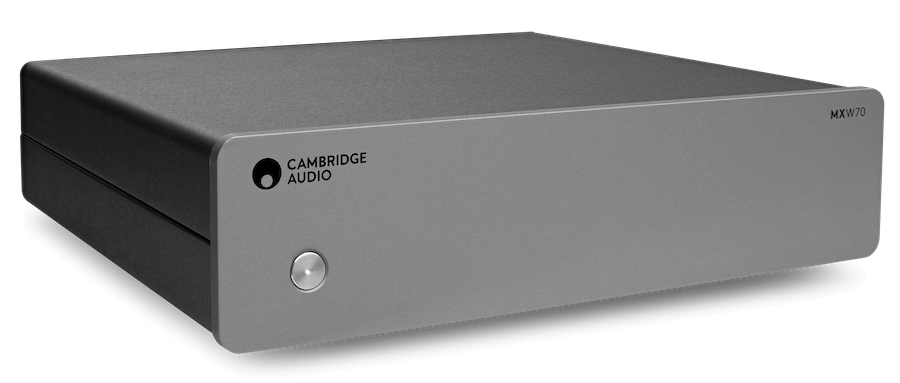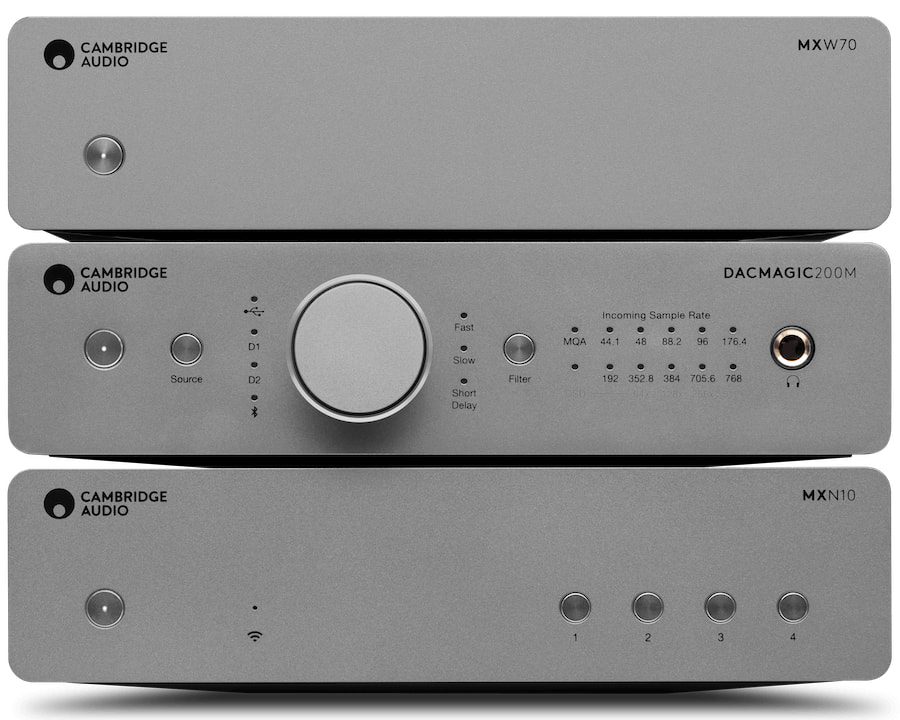At some point, even die-hard full-rack separatists like me have to admit the obvious: space isn’t what it used to be. When your life gets split between a Zook A-Frame ADU cabin on the Shore, a ranch on Florida’s Treasure Coast, and another dwelling in the Garden State—each charming, each compact—the hi-fi rig needs to evolve. The combined square footage of all three is nearly identical to my old home, but thirty years of high-end system purchases didn’t get the memo. That’s where the rebellion begins. Meet the Cambridge Audio MXW70.
Cambridge Audio just joined the half-width uprising—and they didn’t come bearing peace offerings. The new MXW70 power amp is a Class D sniper, aimed directly at WiiM, NAD, Bluesound, Marantz, and SMSL. If you thought the compact amp game was settled, Cambridge just kicked the tea table over.

Designed to lock arms with the MXN10 streamer—which quietly gained digital preamp functionality while the rest of the hi-fi world argued over filters and DAC topology—the MXW70 doesn’t care about your bookshelf aesthetic. It’s not here to look cute. It’s here to do the job. Half-width, full control via the StreamMagic app, and enough Class D muscle to make legacy gear feel bloated. It doesn’t need to prove anything. It just works—tight, focused, and very British in its refusal to over-explain.
I’m sure there are still a few holdouts clutching their toroidal transformers and bemoaning the rise of Class D (none of us care), but based on the overwhelmingly positive response to our recent features on the evolution of Class D—from $130 desktop amps to $50,000 reference monoblocks—it’s clear most of you can see the proverbial forest for the trees. You get it: a compact amp like the MXW70, one that won’t be pampered in a ventilated rack, needed to be this way.
It’ll stay relatively cool—because the notion that Class D can’t sound musical unless it’s wrapped in a $10,000 billet aluminum enclosure is tired. Cambridge knows this. So they kept it simple. Smart topology, good parts, tuned by people who actually listen. The result? An amp that behaves like it belongs in the big leagues but fits on a bookshelf without setting off a smoke alarm.

Cambridge Audio MXW70: Compact Class D Muscle With No Patience for Your Full-Size Excuses
Cambridge Audio didn’t build the MXW70 to win beauty contests. This half-width power amp was designed for tight spaces and tighter tolerances—where ventilation is limited, shelf space is rationed, and sound quality still matters. At just 215mm wide, it looks polite. It isn’t.
You get 70 watts per channel into 8 ohms, 100 into 6, and if you throw it into bridged mono mode, it delivers 250 clean watts into 8 ohms. That’s not theoretical output measured on a cold Canadian morning—it’s actual, usable power thanks to Hypex NCORE Class D modules and Cambridge’s no-BS tuning.
Some Class D amps still sound like lab experiments in progress. This doesn’t. The MXW70 brings clarity, grip, and composure without crossing into sterile territory. It’s neutral without being boring, efficient without sounding dry. And most importantly, it doesn’t flinch when asked to drive real loudspeakers in real rooms.
There are no dials, no glowing tubes, and no vintage cosplay to distract you. Just a steel box that does the work and keeps its mouth shut.
System Building: The Half-Width Path to Glory (and a Few Caveats)

Connectivity? You’re covered. RCA and studio-grade XLR inputs mean the MXW70 doesn’t throw a tantrum when paired with non-Cambridge gear. Whether you’re building a straightforward stereo setup or integrating it into something more complex, it plays nice. Standard 4mm banana plugs make speaker hookup idiot-proof, and there’s even a 12V trigger with pass-through—plus a USB auto-on/off cable that syncs with the MXN10 via the StreamMagic app. Translation: fire up your streamer, and the amp wakes up without demanding your attention like a neglected housecat.
Stack it with the DacMagic 200M and you’ve got a sleek little tower of British engineering—high-res capable, compact, and finished in Lunar Grey aluminum that looks more boutique than budget. You get a proper volume knob (hallelujah), headphone output, and every digital input you could ask for. Just don’t come looking for analog inputs—because none of these units (MXN10, CXN100, or the DacMagic 200M) give you one. So if you’ve got a turntable with a built-in phono stage, tough luck unless you get creative with a Bluetooth transmitter.
Enter Cambridge’s own Alva ST or TT V2 turntables with Bluetooth aptX (with the TT V2)—they’ll play nicely with the DacMagic 200M wirelessly, which isn’t purist-approved but still better than doing nothing. Or, if you want to stay under budget and still add analog sources, the WiiM Ultra has analog outs, a solid interface, and real preamp functionality. Not exactly a gentleman’s solution, but neither was trench warfare—and look how that turned out.
Bottom line: you can build a real system here. Just don’t expect it to accommodate your 2023 Luxman phono stage without a little strategic thinking.
Speaker Matching: Choose Your Fighter
Let’s be honest: no one’s buying the Cambridge Audio MXW70 to drive a $10K speaker system in a purpose-built listening room with oxygen-free feng shui. This amp is for those of us building something smarter—more modest, maybe, but designed to last.
If you’re spending $2,000 to $3,000 on a system—including speakers, source, and cables—you want it to work. You want to enjoy music, not chase your own tail upgrading every six months because something “lacks slam.” That’s who this amplifier is for. Set it up, forget about it, and let it disappear into your day—precisely what Cambridge Audio wants. No sonic fireworks. Just solid performance, long-term satisfaction, and none of the nervosa.

With the Q Acoustics 3020c, it’s a lovely balance—easy to drive, sonically composed, and tonally even. A small-space killer. Add a decent streamer or DAC, and you’re well into hi-fi without triggering a midlife crisis.
The Wharfedale EVO 5.1 and Denton 85 step things up a notch in terms of body and warmth. The MXW70 holds its own, but let’s not pretend it’s swinging Thor’s hammer here. At sane volumes, these pairings sound lush, natural, and just resolving enough to make you smile during your fifth spin of Kind of Blue—not because you “heard something new,” but because it sounds right.
The Cambridge SX50 is a logical house pairing—think of it as the “same pub, different drink” match. Tonally balanced, easygoing, and compact enough to work on shelves or desktops without any complaints. The combo doesn’t thrill, but it doesn’t disappoint either. It just works. And for many people, that’s the win.

The DALI Spektor 2 injects a little more sparkle—Danish enthusiasm meets English discipline. They’re efficient, quick on their feet, and the MXW70 reins them in just enough to avoid treble fatigue. This is the surprise combo that’s more fun than it has any right to be.
Now, for those dreaming of expansion, the CXN100 opens the door to future-proofing. Want to run dual MXW70s as balanced monoblocks? Cambridge isn’t stopping you. You can squeeze more headroom and control out of the setup if you ever upgrade to harder-to-drive speakers. But let’s keep expectations grounded—this isn’t your Maggie driver. Don’t even look at a pair of MartinLogan ESLs. This is precision hardware for realistic systems.
A single MXW70 paired with the MXN10 streamer will run you around $1,100—nearly $700 less than the all-in-one Cambridge Evo 75, which tosses in a full-color screen, subwoofer output, HDMI eARC, and an analog input. On paper, that looks like more value in one box—and for many users, it is. But if you’re building a more modular system with room to grow, the separates approach has its own logic.
Step up to two MXW70s in monoblock configuration and the CXN100 streamer, and you’re looking at $2,300 total—still $1,000 less than the Evo 150, which technically offers less power but adds a phono stage, HDMI, and a wider array of inputs. The trade-off? Flexibility and upgradeability. With the separates, you get Cambridge’s better streamer, more power, and the option to scale. With the Evo series, you get slicker integration. Pick your path—just don’t pretend one kills the other.
Bottom line? This amp wasn’t designed to make headlines—it was designed to disappear into your lifestyle and just work. That’s what makes it smart. And that’s what might make it worth owning.
More to come with this one in late-July.
Available soon for $599 at Cambridge Audio.
